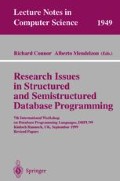Abstract
Currently, there is tremendous interest in semi-structured (SS)data management. This is spurred by data sources, such as the ACeDB [29], that are inherently less rigidly structured than traditional DBMS, by WWW documents where no hard rules or constraints are imposed and “anything goes,” and by integration of information coming from disparate sources exhibiting considerable differences in the way they structure information. Significant strides have been made in the development of data models and query languages [2, 11, 17, 6, 7], and to some extent, the theory of queries on semi-structured data [1, 23, 3, 13, 9]. The OEM model of the Stanford TSIMMIS project [2] (equivalently, its variant, independently developed at U.Penn. [11]) has emerged as the de facto standard model for semi-structured data. OEM is a light-weight object model,which unlike the ODMG model that it extends, does not impose the latter’s rigid type constraints. Both OEM and the Penn model essentially correspond to labeled digraphs. Amain theme emerging from the popular query languages such as Lorel [2], UnQL [11], StruQL [17], WebOQL [6], and the Ulixes/Penelope pair of the ADM model [7], is that navigation is considered an integral and essential part of querying. Indeed, given the lac of rigid schema of semi-structured data, navigation brings many benefits, including the ability to retrieve data regardless of the depth at which it resides in a tree (e.g.,see [4]). This is achieved with programming primitives such as regular path expressions and wildcards. A second, somewhat subtle, aspect of the emerging trend is that query expressions are often dependent on the particular instance they are applied to. This is not surprising, given the lac of rigid structure and the absence of the notion of a predefined schema for semi-structured data. In fact, it has been argued [4] that it is unreasonable to impose a predefined schema.
Access this chapter
Tax calculation will be finalised at checkout
Purchases are for personal use only
Preview
Unable to display preview. Download preview PDF.
References
Abiteboul, S., and V. Vianu. Queries and computation on the Web. ICDT’ 97. 271, 293
Abiteboul, S. et al. The Lorel query language for semistructured data. Intl. J. on Digital Libraries, 1:68–88, 1997. 271
Abiteboul, S., and V Vianu. Regular path queries with constraints. PODS’ 97. 271
Abiteboul, S. Querying Semi-Structured Data. ICDT’ 97. 271, 273
Andries, M., and Paredaens, J.. On instance-completeness for database query languages involving object creation. J. Comp. Syst. Sci., 52(2):357–373, 1996. 294
Arocena, G., and A. O. Mendelzon. WebOQL: Restructuring documents, databases and webs. ICDE’ 98. 271, 274, 294
Atzeni, P., G. Mecca, and P. Merialdo. To weave the web. VLDB’ 97. 271
Bancilhon, F.. On the Completeness of Query Languages for Relational Data Bases. MFOCS’ 78. 274, 290, 294
Beeri, C., and T. Milo. Schemas for Integration and Translation of Structured and Semi-Structured data. ICDT’ 99. 271, 276
Brey, T., J. Paoli, and S. Sperberg-McQuenn. Extensible Markup Language (XML) 1.0. http://www.w3.org/TR/REC-xml 292
Buneman, P. et al. A query language and optimization techniques for unstructured data. SIGMOD’ 96. 271, 274, 291
Buneman, P., and A. Ohori. Polymorphism and Type Inference in Database Programming. ACM TODS, 21:30–76, 1996. 286
Buneman, P. et al. Adding structure too unstructured data. ICDT’ 97. 271
Bussche, J. Van den et al. On the Completeness of Object-Creating Database Transformation Languages. JACM, 44(2):272–319. 294
Bussche, J. Van den, and E. Waller. Type inference in the polymorphic relational algebra. PODS 99. 292
Chandra A.K and D. Harel. Computable queries for relational data bases. J. Comp. Syst. Sci., 21:156–178, 1980. 272, 294
Fernandez, M., D. Florescu, A. Levy, and D. Suciu. A query language for a web-site management system. SIGMOD Record, 26(3):4–11, September 1997. 271, 274
Florescu, D., A. Levy, and D. Suciu. Query containment for conjunctive queries with regular expressions. PODS’ 98. 272
Grahne, G., and L.V.S. Lakshmanan. On the Difference between Navigating Semi-structured Data and Querying It.Technical report, Concordia University, Montreal, Canada, August 1999 in preparation. 290
Gyssens, M., L.V.S. Lakshmanan, and I.N. Subramanian Tables as a paradigm for querying and restructuring. PODS’ 96. 280
Hull, R.. Managing Semantic Heterogeneity in Databases: A Theoretical Perspective. PODS’ 97. 274, 294
Manna, Z., Mathematical Theory of Computation.McGraw-Hill, New York, Montreal, 1974. 281
Mendelzon, A. O., and T. Milo. Formal models of web queries. PODS’ 97. 271, 293
Lerat, N., and W. Lipski. Nonapplicable nulls. TCS, 46:67–82, 1986. 291
Ley, M.. Database Systems and Logic Programming Bibliography Server. http://www.informatik.uni-trier.de/ ley/db/. 275
Nestorov, S., S. Abiteboul, and R. Motwani. Extracting Schema from Semistructured Data. SIGMOD’ 98. 292
Paredaens, J. On the expressive power of the relational algebra. IPL, 7:107–110, 1978. 274, 290, 294
Rajaraman, A., and J.D. Ullman. Integrating Information by Outerjoins and Full Disjunctions. PODS’ 96. 274
Thierry-Mieg, J., and R. Durbin. A C.elegans database: syntactic definitions for the ACEDB data base manager, 1992. 271
Ullman, J. D. Database Theory-Past and Future. PODS’ 87. 273
Author information
Authors and Affiliations
Editor information
Editors and Affiliations
Rights and permissions
Copyright information
© 2000 Springer-Verlag Berlin Heidelberg
About this paper
Cite this paper
Grahne, G., Lakshmanan, L.V.S. (2000). On the Difference between Navigating Semi-structured Data and Querying It. In: Connor, R., Mendelzon, A. (eds) Research Issues in Structured and Semistructured Database Programming. DBPL 1999. Lecture Notes in Computer Science, vol 1949. Springer, Berlin, Heidelberg. https://doi.org/10.1007/3-540-44543-9_17
Download citation
DOI: https://doi.org/10.1007/3-540-44543-9_17
Published:
Publisher Name: Springer, Berlin, Heidelberg
Print ISBN: 978-3-540-41481-0
Online ISBN: 978-3-540-44543-2
eBook Packages: Springer Book Archive

